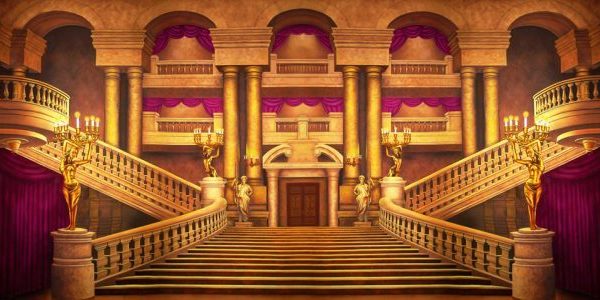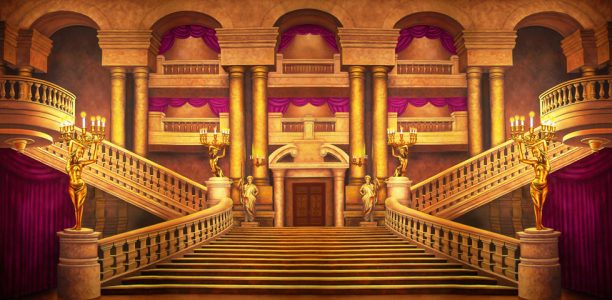Going Beyond the Script with Stage Backdrops
The Director’s role goes beyond the words, lyrics, staging, casting, costume, backdrops, hair/make-up, scenic design, and everything else involved with launching a production. Their role is, first and foremost, to engage the audience and create a unique experience.
There are many tools at the Director’s hand. Obviously, casting choices are key. We all know that actors are a great storytelling tool. You can accomplish some shows with nothing more than a script and a single actor. However, for those of us that want a little something more, there are many options available. Your creativity and planning must combine to create a beautiful scenic presentation. You can easily accomplish this through proper lighting techniques and carefully selected stage backdrops.
Everything is possible. From a single spot light shining down on an empty chair on an otherwise black stage, to an elaborate Paris Opera House with secret passageways and crashing chandeliers, it all comes down to engaging the audience. Being able to draw them into a realm of fantasy, heartbreak, forbidden lands, pure joy, and dance galore is the mark of a great show.
Enhancing the Scene With Stage Backdrops
House lights up.
Your set is built and held together with super glue in at least one location. Your beautifully rented stage backdrop is draped majestically. The actor’s marks are placed and labeled in glow tape. Everything looks great.
House lights down.
The stage is set. The actors are anxious. The orchestra is queued. And the story begins…
Lighting cue one comes up and the stage is filled with gentle amber lighting.
The actors have all their lines memorized. Vocals are on pitch and harmonized. The music swells. Lights come on and off. The audience applauds.
Congratulations. You have a show that works. Another school performance or community theater production opens and closes. Let’s all go out for burgers.
Question.
Where’s the excitement? Where is the “wow” factor? Is the audience talking about a particular scene or that moment?
Grand Theatre Foyer
Less is More
We’ve all heard this phrase before. What does this mean in context? Actors shouldn’t amble across the stage – each movement should have a purpose. Similarly, don’t just clutter the stage: use set pieces, practicals, and props that serve a purpose.
Use stage backdrops that create the setting and light them properly to create the mood. With a properly placed backdrop, you won’t need all the extra painted lumber in front.
Let’s move away from the traditional unit sets and create a new and dynamic show with the same, decades’ old script.
Consider TheatreWorld Backdrops’ “Grand Theatre Foyer” (seen above) which can be used for a variety of shows from PHANTOM OF THE OPERA to HELLO, DOLLY to BEAUTY AND THE BEAST. This backdrop already has some unique lighting elements built in via painted effects. The candelabras glow due to the use of specialized paints and the top third of the drop is lit more brightly than the bottom two thirds.
The eye is naturally brought in to the center of the backdrop from all directions.
Lighting Options
Consider using some up cross-lighting designs that cascade upwards and across the candelabras. Then, utilize some down cross-lighting from the wings on to the stage. The object is to create depth and movement from the backdrop to the edge of downstage.
This particular drop has a lot of golds, yellows, and magentas in it, which are extremely warm tones. It’s very welcoming and engaging, excellent for groups and party scenes. Any warm color lighting will be lost unless it is a focused beam.
Therefore, to create some additional drama, try using blue LED up lighting in the bottom left and right corners of the stage to enhance the magenta colors on the sides of the staircase.
For more isolated character moments, asides, and solos, switch to drop lighting or a single pale blue spot. Isolation should feel separate from the background. It should feel out of place. Try eliminating any warm up-lighting and switch to cool tones in a blue and green palette.
Scenic Options
Some backdrops give the feeling of wide open space with landscaping that stretches for miles. This backdrop, however, doesn’t add visual expansion horizontally, but rather vertical height and depth. Your eye naturally goes up the staircase to the center of the image. Avoid adding set pieces too close in front of this particular stage backdrop because they will be visually lost.
Try this instead. Use four lamp posts to create a pathway that expands from the base of the backdrop’s stairs out to midway stage left and right. This will continue the visual sight line out of the drop and on to the stage.
Additionally, it’ll give you three unique staging areas to work in on the stage itself. Depending on the size of your stage, don’t make the lamp posts too bulky. They should simply serve as visual guideposts. Plus, you don’t want them to get in the way of the actors and the choreography.
Note that this drop is very symmetrical, as well. Any scenic design and choreography should emulate this and allow for mirroring. Asymmetrical designs won’t work very well, but can be accomplished through lighting or stagings down stage left or right.
Budget Options
Not everyone has a true theatrical space to work in, nor the budget to pay for expensive lighting designs, costumes, and construction materials. Here are some helpful tips for creating the options described above, but while staying on or under budget.
Stage Lighting Options
For various up lighting techniques, lights placed near or on the ground are needed. Go down to your local hardware store and pick up some handheld, portable, or clamp-on work lights, which will range from around $8 to $35. You can also try replacing an incandescent bulb with a CFL or LED light to save on heat generation. You may also use different colored bulbs.
To create diffuse, or scattered fill lighting, cover the light with parchment paper. (Found in your grocery store near the aluminum foil.) Be careful not to let the parchment paper rest on the bulb itself. Use wooden clothespins to secure the paper to the safety cage or casing.
To create directional or cut lighting, create barn doors or lighting boxes for your new light using some cut plywood, hinges, and some black paint.
Scenic Options
To create the lamp posts, check out your school’s music department and ask to borrow some microphone stands. If you are not based out of a school, used microphone stands can be acquired inexpensively and are very useful to have around. These stands make great bases and can be the skeleton for your lamp posts. Use cardboard, plastic crates or cartons, or thin plywood to create the base and shapes of your lamp post. Make sure all of your added pieces are well-secured to the microphone stand. Insert a battery operated candle to the top of the stand where the microphone sits for a cool “lit lamp” effect and build the lamp housing around it.
Paint your pieces either the same color as the stand (if any part of the stand is still visible) or use the stand’s color as a trim color. Try painting the lamp post faces an opulent gold to match the backdrop, but use the microphone stand’s color as accent for detail work.
Summary
Stage backdrops each have their own artistic personality. Think of it as part of the scenic design that you don’t have to build. However, don’t forget to include it in and let it blend together with what is on the stage. Avoid general fill lighting. The edges are allowed to fade off into black. Use set pieces strategically and avoid clutter or blocking the backdrop too much.
Most importantly, get creative. Try something new. (Just don’t tear or get paint on our backdrops!)
Draw the audience in and make them forget where they are.
Have additional ideas?
Creative design is fluid. Think these ideas stink? Love them? Have additional ideas? We’d love to hear from you!
Have you used this backdrop before? What did you do in your scene? Send us your pictures and leave a comment below.








